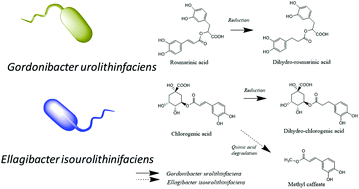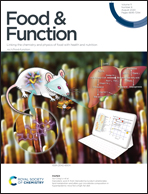Metabolism of different dietary phenolic compounds by the urolithin-producing human-gut bacteria Gordonibacter urolithinfaciens and Ellagibacter isourolithinifaciens†
Abstract
Gordonibacter urolithinfaciens and Ellagibacter isourolithinifaciens are two human gut bacterial species that convert ellagic acid into urolithins. Urolithins are bioactive postbiotics produced by dehydroxylation reactions catalyzed by different catechol-dehydroxylases. The metabolic ability of these anaerobic bacteria on other dietary-phenolic compounds is unknown. In the present study, we evaluated the metabolism of flavonoids (quercetin, hesperetin, hesperidin, nobiletin, catechin, isoxanthohumol), isoflavonoids (daidzein), coumarins (esculetin, umbelliferone, scoparone), phenylpropanoids [caffeic acid; 3-(3′,4′-dihydroxyphenyl)propanoic acid (dihydrocaffeic acid); rosmarinic acid, and chlorogenic acid], benzoic acid derivatives (gallic acid, ellagic acid), lignans (secoisolariciresinol diglucoside), stilbenes (resveratrol), and secoiridoids (oleuropein) by G. urolithinfaciens DSM 27213T and E. isourolithinifaciens DSM 104140T. Both strains metabolized ellagic acid leading to the characteristic urolithins. They also metabolized caffeic, dihydrocaffeic, rosmarinic, and chlorogenic acids. The rest of the phenolic compounds were not transformed. Catechol dehydroxylation and double bond reduction were prominent transformations observed during the incubations. The enzymatic activities seem to have a narrow substrate scope as many catechol- (quercetin, catechin, esculetin, gallic acid) and double bond-containing (resveratrol, esculetin, scoparone, umbelliferone) phenolics were not metabolized. The catechol-dehydroxylase activity was more efficient in E. isourolithinifaciens, while the reductase activity was more relevant in G. urolithinfaciens.

- This article is part of the themed collection: International Conference on Polyphenols and Health (ICPH2019) collection


 Please wait while we load your content...
Please wait while we load your content...